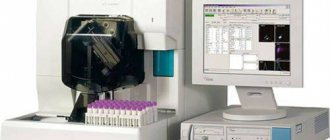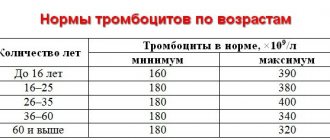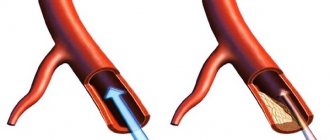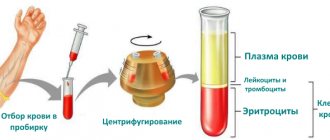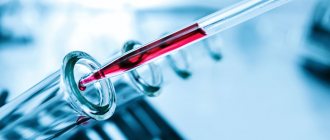0
Author of the article: Marina Dmitrievna
2017.07.30
430
Blood analysis
If we look at children's tests, then parents are clear about the number of red blood cells and the level of hemoglobin in the child's blood. However, there are indicators that few people are familiar with that are also increasing. If the hematocrit is elevated in a child, this means that you need to immediately consult a doctor and take tests that will determine what is causing the frightening symptoms.
What does this mean?
Hematocrit is the main indicator that helps determine the number of red blood cells in a child’s blood. Usually measured as a percentage in a complete blood count. Hematocrit determines how stable and how the process of oxygen transfer to the blood and heart occurs. Nowadays, automated technology is used that independently determines the level of hematocrit in the blood. Previously, you had to independently determine whether the level of red blood cells was increasing, and this was difficult, the procedure took a lot of time.
How to treat elevated hematocrit in a child
Some parents immediately begin to panic if they learn from the doctor that the child’s hematocrit is elevated. What does it mean? Don’t worry right away; in order to accurately establish the cause of the deviations, the doctor will suggest conducting another whole chain of tests. And once the cause is established, treatment will be prescribed if necessary.
First of all, in such cases, it is recommended that the patient be provided with proper nutrition, which includes a large amount of fortified foods. If you follow all the doctor’s instructions, the normal level of red blood cells will soon be restored.
The doctor will determine exactly how high the child's hematocrit is, and if these indicators are insignificant, and the results of other tests do not show any abnormalities, then this may be due to physiological development.
Hematocrit: normal in children
Hematocrit is measured as a percentage, so the indicators are different for each age. Normal hematocrit in children:
- on the fifth day of life and before the end of the first month - 53-49%.
- for infants up to one year old – 45%;
- in children from 1-3 to 5 years old – 35%;
- in children from 5 to 9-10 years old – 37%;
- in children aged 10-15 years – 39%;
- in children over 15 – 47%.
It is believed that the hematocrit in the blood is increased when it reaches a level of more than 62%, and in children older than one year - higher than 44%.
It is worthwhile to carefully examine the table and, at the slightest deviation, contact a doctor who will help you understand what is causing the high indicators and prescribe preventive actions.
Hematocrit level norms
Low rate
The causes of low hematocrit in children are:
- pathology of red bone marrow;
- anemia;
- hyperproteinemia;
- intensive infusion therapy;
- excessive fluid intake due to diabetes insipidus;
- diseases accompanied by hemolysis of red blood cells (malaria, leukemia);
- transfusion of incompatible blood;
- hemolytic disease of newborns;
- poisoning with hemolytic poisons (arsenic compounds, nitrates, amines, benzene derivatives).
Important information: What do low eosinophils in an adult indicate in a blood test?
Blood diseases
If a child has a low hematocrit, this means that a possible problem lies in blood diseases.
The most common cause is acute leukemia.
This is a malignant disease in which the process of hematopoiesis in the bone marrow is disrupted. Children aged 2-5 years often get sick. Along with a low hematocrit, thrombocytopenia, anemia (decrease in red blood cells and hemoglobin), an increase in leukocytes, disappearance of basophils and eosinophils, a large number of blast cells and the absence of intermediate cellular forms are detected.
Kidney diseases
Hematocrit may decrease with pyelonephritis, narrowing of the renal artery, thrombosis, polycystic disease and tumors.
Hyperproteinemia
Proteins (albumin, fibrinogen, globulins) are a component of plasma. The more there are, the larger the plasma volume. With hyperproteinemia, the level of proteins increases, which is manifested by a slight drop in hematocrit.
Reasons for increased hematocrit
If the hematocrit in the blood is increased, this does not mean that bacteria have entered the body or diseases are developing. This phenomenon may be associated with a physical and psychological state that is disrupted as a result of exposure to external factors. In such cases, an increase in hematocrit does not affect the health and condition of the child. There are 6 reasons for increased red blood cell levels.
- Plasma loss and dehydration. Dehydration occurs as a result of loss of fluid in the body, which occurs with excessive diarrhea, vomiting, or after vigorous physical activity. Water leaves the body, a compensation process occurs, and therefore the level of blood cells rises.
- Injuries or burns. With burns and severe injuries to the skin, the wounds begin to become overgrown with blood clots, and because of this, the level of red blood cells increases, especially in children, since their body is not sufficiently formed and strengthened.
- Erythremia. A bone marrow tumor in which blood cells are produced more intensively. The reasons are different, but an increase in red blood cells threatens the emergence of dangerous blood diseases.
- Kidney diseases. During diseases and inflammatory processes in the kidneys, red blood cells increase, since the body's metabolism is completely or partially disrupted. These may be tumors or polycystic disease, due to which most of the fluid is lost in the urine and red blood cells increase.
- Use of drugs and antibiotics. If you often use antibiotics and drugs in large quantities, this threatens to impair the child’s condition, and the level of red blood cells in the blood will rise.
- Anemia or leukemia. Perhaps anemia begins to develop in the blood, which is caused by a lack of hemoglobin. If treatment is not taken on time, this threatens the development of leukemia, as a result of which the level of red blood cells will begin to increase inexorably.
Normal and pathological blood supply to the brain
Hematocrit is increased: causes of deviations in young patients
High levels of total AA do not always indicate the development of serious disorders in the body. Sometimes jumps in the percentage of erythroid cells are associated with physiological factors and are temporary changes.
If the hematocrit is increased due to the influence of internal or external harmless causes, then parents should not worry about the baby’s health. These factors include:
- Dehydration . When plasma volume decreases due to lack of fluid, then in comparison with other fractions, the hematocrit value appears to be high. But in fact, this is a temporary phenomenon that will return to normal as soon as the child starts drinking more water. This also applies to cases where dehydration is caused by vomiting, overheating, severe sweating, or diarrhea. But again, the solution to the problem depends on drinking enough fluid.
- Inhalation of thin air . When climbing to a height, all children face a lack of oxygen in their tissues. The body compensates for hypoxia by producing more red blood cells, which supply O2 to each cell. Once the patient returns to the previous atmospheric pressure, Hct will return to normal levels.
But there are also more serious reasons for increased hematocrit, which should alert both parents and pediatricians. If a blood test shows a high percentage of hematocrit value, then it is necessary to conduct additional diagnostics of the body to exclude the development of the following pathologies:
- Polycythemia is a malignant disease that impairs the functionality of the bone marrow;
- Chronic hypoxia is a constant lack of oxygen, which most often occurs in patients with diabetes and in smokers (young children can breathe cigarette smoke in the presence of smoking adults);
- Tissue changes in the kidneys (tumor, cysts, hydronephrosis);
- Injuries, bleeding, burns;
- Anemia of various origins;
- Inflammation in the abdominal cavity, ascites (fluid accumulation in the abdomen);
- Leukemia;
- Severe poisoning.
In addition, Hct increases due to glucocorticoid use. These hormonal agents promote bone marrow activation and increased red blood cell production. Diuretics have the same effect. But the use must be long-term or uncontrolled in order to reject the UAC readings.
Chronic stress through school or family circumstances can influence changes in the ratio of fractions in children.
If high numbers are observed in a newborn, then most likely they are caused by hypoxia during gestation and childbirth. In this condition, one cannot hesitate; it is urgent to restore blood supply and oxygen saturation to the brain so that the patient does not become disabled - physically disabled or mentally retarded.
Why is an increase in hematocrit dangerous in children?
When the hematocrit increases, the blood becomes thick and viscous, and this threatens the formation of blood clots, which slow down the blood circulation process. This phenomenon is dangerous because it can cause serious diseases of the heart and blood vessels, into which blood and oxygen do not pass in normal quantities.
For children whose mothers did not stop breastfeeding, such symptoms are doubly dangerous, since diseases of the cardiac system and blood vessels can develop, which develop into chronic forms.
Taking blood from a baby to determine the hematocrit level
Hematocrit below normal
A blood viscosity test is prescribed for people who have severe symptoms of dehydration, severe vomiting due to poisoning, or diarrhea. Biological indicators are affected by the age and gender of a person. Doctors have a special formula used to establish the hematocrit number. It is calculated as follows:
- The content of red blood cells is determined as a percentage or as a fractional component.
- The result obtained is multiplied by 0.001.
A high hematocrit in newborns is considered normal. The value of this indicator is 20-30% higher than in adults. Then the number of red blood cells decreases sharply. It is considered normal when the hematocrit value in the blood is 40-45%. In pregnant women, the number of red blood cells begins to decrease from the 20th week, and then returns to normal after childbirth.
An increase or decrease in the number of red blood cells can be caused not only by serious illness or exposure to traumatic factors such as burns. In people who like to smoke, the hematocrit is higher than normal, because the process of inhaling tobacco provokes oxygen starvation of the tissues. The patient may not even realize that his body is in a state of constant stress. The hematocrit rate may change for the following reasons:
- Continuous or occasional work at height. Residents of high mountain areas and climbers are susceptible to the influence of this factor.
- Taking anabolic steroids, which provoke muscle growth, lowers hemoglobin. As a result, the hematocrit number decreases.
Experts consider deviations from the norm in the form of a decrease or increase as a sign of a painful pathology or physiological characteristics of the child. High Ht indicates an increased number of formed elements, which make the blood viscous and thick. Having blood in this state provokes the formation of blood clots.
In babies under one year of age, deviations from the normal Ht are most common, and this is not a sign of disease
The hematocrit is reduced - this means that the volume of blood cells has decreased, and they are responsible for supplying nutrients and oxygen to the organs. There is a violation of the acid-base balance, leading to oxygen starvation of the cells, which negatively affects the general condition of the baby. Weakness appears, the heartbeat quickens, the skin becomes pale, and there is shortness of breath.
A decrease in hematocrit is recorded when its level is clearly low, that is, it drops to 25%. Having discovered that the hematocrit is reduced, the doctor prescribes an additional examination for the small patient to determine the cause.
Anemia is the most common cause of low hematocrit in a child
As a rule, a decrease in Ht is a consequence of the accumulation of excess fluid, due to which the blood thins and the percentage level of red blood cells and plasma changes (overhydration), and hemoglobin decreases (see also: how to treat high hemoglobin in a child?). The cause may be hyperproteinemia (excessive concentration of proteins). Such changes are caused by:
- Severe blood loss.
- Violation of the formation of red blood cells in the bone marrow towards a decrease in their number or size.
- Hereditary or acquired hemolytic anemia, typhoid fever, malaria, hemolytic poisons, in which rapid destruction of red blood cells occurs.
- Intravenous administration of large amounts of fluid for impaired renal function, leading to an increase in blood volume.
- Various types of anemia.
- Overhydration - blood thinning due to disturbances in the excretory system, insufficient blood circulation, water intoxication.
- Increased protein levels in the blood (hyperproteinemia). Occurs with frequent vomiting, acute infections, diarrhea, paraproteinemic hemoblastoses, Hodgkin lymphoma, myeloma.
Anemia is a common cause of decreased hematocrit. The child needs medical supervision and the establishment of a proper diet. The doctor may suggest taking medications that increase Ht.
In fact, the hematocrit number determines the thickness of the blood. When the hematocrit is low, the blood is too thin; when it is high, the blood is too thick. Red blood cells make up 99 percent of all blood cells, so their number is decisive.
Remember that the tests are done not so much for you as for the specialists. It’s good to understand what’s what and what certain meanings mean, but it’s better not to make independent decisions and not self-medicate. Each situation requires an individual approach. For example, in the case of increased hematocrit, first you need to determine what exactly led to it.
The most important thing in a person’s life is health, and the health of a child is doubly important for parents. In the article we will tell you what hematocrit is, what the norms for this blood indicator are for children of different ages, and also answer questions about low and high hematocrit.
Red blood cell volume (hematocrit) is the total number of white blood cells and red blood cells in the blood plasma, expressed as a percentage. The indicator takes into account all formed elements, but red blood cells have diagnostic value. In simple terms, the hematocrit determines the viscosity of the blood. In the study protocol it is designated by the following abbreviation – HCT.
The research sample is capillary or venous blood. The biomaterial taken for research is placed in a graduated glass tube and centrifuged in the laboratory. After separating the blood components, the results are calculated using the measuring scale of the test tube.
The normal value for adults is:
- formed elements – 45%;
- blood plasma – 65%.
If hematocrit is examined in children, the norm depends on age and presents the following picture:
- in infants – 56%;
- from the 5th day of life to a month – 53-45%;
- from one to 5 years this figure varies from 35 to 37%;
- at the age of 10 years –39%;
- in adolescents it is 47%.
The deviation of the hematocrit number indicates the degree of blood concentration.
A hematocrit higher than normal is a specific laboratory sign that can indicate the occurrence of both non-serious pathological processes and life-threatening diseases. Increased deviations from normal values can develop in people of any age and gender.
What to do with such indicators?
If the hematocrit is elevated, then it is impossible to immediately make a diagnosis and understand what is causing it, since it is necessary to consult a doctor who will prescribe special tests. There are times when you can easily restore the normal level of red blood cells in the blood by simply adding some foods to your diet and eliminating junk foods from the menu. And there are times when this is not enough.
The hematocrit may increase when the baby is a passive smoker or is exposed to nicotine in breast milk from a smoking mother. In this case, it is urgent for parents to give up this bad habit, which can negatively affect the child’s health.
If there is an increased hematocrit and level of red blood cells in the blood of a child, then first of all you need to follow the general recommendations.
- Contact a pediatrician for advice, who will answer your questions, conduct an examination and determine why such symptoms are dangerous and what treatment is needed (in case of disease development).
- Take the necessary tests that will help determine whether the levels of red blood cells and hemoglobin in the child’s blood are normal.
- Parents need to exclude from the diet harmful foods, alcohol and cigarettes, which affect the child’s health, because nicotine is transmitted to the baby through breast milk.
Alcohol and nicotine impair blood flow to the baby’s organs, which causes tissue hypoxia.
If the child’s hematocrit is low, then get tested, because a low indicator indicates that malfunctions have occurred in the body or diseases are developing. As a result of a reduced hematocrit, the hemoglobin level may also decrease, which threatens the development of anemia and leukemia.
Please note that if you do not get tested in time and do not consult a doctor with such symptoms and an increased hematocrit, this threatens to impair the child’s general health, and the reasons for this may be different. You also need to take a general blood test, which will show whether your hemoglobin is normal.
You can learn about the properties and characteristics of a high hematocrit from the video, which will help you understand the danger of changing indicators in a child’s laboratory tests:
When and how the analysis is carried out
Determination of hematocrit is an integral part of a general clinical blood test. This is a mandatory research method for suspected somatic diseases in a child. Indications for a general blood test are:
- preventive examination (upon admission of a child to kindergarten and school);
- examination and diagnosis before hospitalization;
- the presence of symptoms of inflammatory and infectious diseases (fever, malaise, cough, weakness, pain);
- suspicion of oncological and hematological pathologies;
- monitoring the effectiveness of treatment.
Blood for analysis is given on an empty stomach, so the child must refrain from eating food in the morning before visiting a medical facility. No special preparation required. It is important that the child is in a stable psycho-emotional state. To do this, parents need to calm him down.
The analysis requires capillary (from a finger) or venous blood. In the first case, the nurse or doctor treats the finger with cotton wool and antiseptic (alcohol). For right-handed people, the material is most often taken from the ring finger of the left hand, and for left-handed people - the finger of the right hand. After this, the skin is pierced with a disposable scarifier. The puncture size is 2-3 mm. The first drop of blood is removed with a cotton swab. A capillary is used to collect blood. It is a glass rod that collects blood.
After collecting the material, a cotton wool is applied to the finger. This is necessary to stop the bleeding. Sometimes several punctures are required (if there is not enough blood coming out). Less commonly, in children, material is taken from the ulnar vein of the non-working arm. First, the nurse applies a tourniquet (on the fabric so as not to injure the patient’s delicate skin). In this case, the child must work with his fist, squeezing and unclenching it alternately.
Important information: Why are leukocytes in the blood elevated during pregnancy?
The puncture site is treated with an antiseptic and a needle is inserted. Initially, the angle is about 45º, but then it is changed (the needle is inserted along the vein almost parallel to the skin). Special containers are used for collection. After taking venous blood, remove the tourniquet and remove the needle. The arm is bent at the elbow. It should remain in this position for about 10 minutes.
To calculate the hematocrit, the biological material is sent to the laboratory. This indicator is assessed by centrifugation or using special automatic analyzers. The material is placed in a graduated glass tube. Using a centrifuge, plasma is separated from formed elements (red blood cells). The latter are located at the bottom of the test tube. The ratio of red cells to plasma is assessed using a scale. The results are recorded in fraction or percentage form.
Decreased hematocrit
The mechanism of reduced hematocrit is the opposite: the hematocrit will be reduced in cases where the number of formed elements decreases with a normal amount of plasma, or when the volume of plasma increases in relation to the normal amount of formed elements. External manifestations of a low hematocrit can be different. There are also several reasons for a decrease in hematocrit.
Overhydration
Hematocrit is the second most important indicator of a general blood test after hemoglobin. What it should be like for pregnant women can be found out here https://krasnayakrov.ru/analizy-krovi/gematokrit-pri-beremennosti-kakovyi-ego-normyi.html
This is the opposite of dehydration, where there is excess fluid in the body. The most common cause in childhood is due to impaired renal function.
The most common manifestation is swelling. Swelling can be detected both on the face and on the legs. In addition, hidden swelling can be detected in a child - the so-called “rubber band” symptom, when socks leave pronounced indentations on the skin in the evening.
The mechanism for lowering the hematocrit level here is associated with an increase in the volume of blood plasma with a normal number of red blood cells. At home, you can carry out herbal medicine: give your child various diuretics to drink for 1–2 weeks, but only when the swelling is not very pronounced and nothing bothers the child. As with dehydration, urination needs to be monitored.
Anemia
Anemia can be of different types. The most common are the following.
- Deficiency (iron deficiency, folate deficiency, B12 deficiency) . They are associated with a lack of microelements in the body, as a result of which the number of formed elements in the blood decreases, hence the decrease in hematocrit. Treatment consists of restoring the balance of vitamins and microelements in the body. Sometimes it is enough to take 1-2 courses of multivitamins, but if the exact nature of anemia is known, iron, folic acid or vitamin B12 supplements are prescribed.
- Posthemorrhagic anemia - resulting from bleeding . They, as a rule, are not typical for children, but can arise as complications after surgical interventions. They are treated exclusively in a hospital under the strict supervision of doctors. The most effective treatment is transfusion of blood components, red blood cells and/or fresh frozen plasma.
- Aplastic anemia. This type is most typical for childhood. As a result of dysfunction of the bone marrow, the formation of blood cells decreases against the background of a relatively constant amount of plasma, hence the decrease in hematocrit. They are detected during regular examinations by a pediatrician and a general blood test.
Hyperproteinemia
This is an increased amount of protein in the blood plasma; the protein, as it were, attracts intercellular fluid into the bloodstream, the density of the blood decreases, and the hematocrit decreases. This often happens when feeding children cow's or goat's milk, which contains much higher protein content than breast milk. Accordingly, the most adequate treatment would be breastfeeding. In situations where breastfeeding is not possible, low protein formulas should be sought.
Although hematocrit is not the main indicator in a general blood test, a change in its normal values will indicate that something is going wrong in the body. If you are concerned about your child’s condition, for example, his skin is pale or, on the contrary, there is redness, the baby often asks for a drink, or you notice swelling, contact your pediatrician. The doctor will order a complete blood test, which will show whether there is any cause for concern. Be healthy!
source
What is hematocrit
Our blood is one of many types of tissue in our body. Like any tissue, it consists of cells and intercellular substance. Its main feature is that it is liquid, the cells are not connected to each other and are free floating. Only in this form can blood perform its circulatory function.
Blood cells are red blood cells, leukocytes and platelets, with the main position here being occupied by red blood cells - erythrocytes. There are a thousand times more of them than leukocytes and platelets.
The liquid part of blood is plasma. It consists of 90% water, the rest being proteins and other organic and mineral substances.
The content of the liquid part in the blood is approximately 60%, the content of cells is respectively 40%.
So the percentage or volume content of cell mass in relation to plasma is the hematocrit. The term comes from the Greek roots hemat (blood) and krites (judge). Here we can talk about all blood cells or only red blood cells, which does not significantly change the essence of the concept (leukocytes and platelets occupy no more than 1% of the total cell mass).
It is determined either as a percentage or as a decimal fraction.
If the hematocrit in a child’s blood is low, what does this mean?
Let's figure out what this means if the hematocrit in a child's blood is low, and when this indicator should be measured.
The composition of the blood and the number of formed elements respond to the influence of external and internal factors. Even minor pathological disorders lead to changes in laboratory blood parameters.
Measuring the hematocrit value will allow diagnosing anemia at an early stage, when the disease does not manifest itself in the form of clinical symptoms. A decrease in the indicator will also indicate an increase in total protein levels or overhydration.
General information about the indicator
The hematocrit value in medicine is defined by two concepts:
- total volume of red blood cells in blood plasma;
- the ratio of the total volume of all blood cells to the total volume of blood.
It should be noted that the equivalent use of these two concepts is permissible, since 99% of the total number of blood cells are directly erythrocytes. It is known that up to 48% of the blood is cells (leukocytes, erythrocytes, platelets), and 65% is plasma.
The method for determining the indicator is simple: the collected venous blood is placed in a special measuring tube with graduation. The tube with the biomaterial is centrifuged. As a result, the formed elements end up in the sediment, the plasma on top. The total volume of deposited elements is an indicator of hematocrit.
Currently, the process is automated and does not have a large error due to the subjective assessment of the laboratory assistant. However, the risk of obtaining inaccurate results cannot be excluded. This is possible at the stage of taking biomaterial.
If the baby’s vein was tied with a tourniquet for a long time or hemolysis (destruction of red blood cells) occurred in the test tube, then the obtained indicators are unreliable. The biomaterial should be taken again.
A repeat study is also necessary if results are obtained that deviate slightly from the norm or are at the lower limit of the norm. It is necessary to understand precisely whether such a deviation was the result of the influence of temporary external factors or a sign of a disease.
When should you check your hematocrit?
The hematocrit value is not determined separately from other indicators of the general blood test. Since this data is not enough even for a screening examination.
The value of hematocrit is important to consider when suspecting anemia, assessing the degree of dehydration, assessing the severity of hypoxia, kidney disease (polycystic disease, hydronephrosis, neoplasms), suspecting an increased amount of proteins in the blood, as well as excess water content in the child’s body.
Normal hematocrit in children
A general blood test is taken from the baby in the first days of life after birth. This is necessary to assess the health of the newborn. The hematocrit value up to 14 days normally varies from 40 to 65%. Then it begins to gradually decrease.
In the first month it is 30 - 55%. In the second month from 27 to 43%. At 3 months the maximum values can normally reach 44%.
From 3 to 6 months, the reference values for the value under consideration should be in the range from 30 to 41%. From six months to 1 year the norm is from 33 to 43%.
Starting from 1 year and up to 12 years, the permissible hematocrit value is 30 - 42%. At the onset of puberty, large-scale changes occur in the adolescent’s body.
Hormonal levels and many laboratory parameters change, including hematocrit. The norm for girls from 12 to 15 years is from 34 to 41%, for boys – 37 – 45%.
From 15 to 18 years of age, the reference hematocrit values are 31-44% and 38-49% for girls and boys, respectively.
Read further: All the reasons for increased alkaline phosphatase in a child
What does it mean if the hematocrit in a child’s blood is low?
Important: in newborn infants, a moderate decrease in the hematocrit value is a variant of the physiological norm. Therefore, it is fundamentally important to take into account the age of a small patient when deciphering the obtained analysis results.
Anemia
A consistently low hematocrit in a child is a common sign of anemia. The disease is a group of similar clinical and hematological syndromes, united according to the principle of common manifestations:
- decrease in hemoglobin concentration in human blood;
- a combined decrease in the level of red blood cells, which is accompanied by a natural drop in the hematocrit value.
The etiology of the disease is different. The main reasons include:
- unhealthy diet, which is dominated by lactic acid products,
- vitamin deficiency and disordered diet (rare meals).
A mild form of anemia may be accompanied by the child’s weakness and increased fatigue; children begin to study worse due to decreased concentration.
A more pronounced form is characterized by shortness of breath, frequent headaches, insomnia and decreased appetite in children. As a rule, children with anemia have pale skin and mucous membranes.
Dry skin, a yellowish-gray complexion, drowsiness, irritability, hair loss, brittle nails, a desire to eat chalk, earth, etc. are also often noted.
Treatment of the disease directly depends on the etiology and is selected strictly by the attending physician. If necessary, iron and vitamin B12 supplements are selected for the child. It is important to review your diet by adding foods rich in iron and vitamins. Severe stages of the disease require red blood cell transfusion.
Infections
In children, the causes can also be infections of various etiologies and helminthic infestations.
The peculiarity of the disease is its long-term course without the manifestation of clinical symptoms. It is detected in children during routine medical examinations, which is why it is so important not to miss them.
Hyperproteinemia
A decrease in hematocrit is characteristic of a state of hyperproteinemia, when the level of proteins in the body increases significantly. In this case, you should undergo additional diagnostics to clarify the reasons.
Possible causes: multiple myeloma, hyperglobulinemic purpura and macroglobulinemia.
A similar condition is also observed during intoxication of the body, when the kidneys are not able to fully detoxify harmful substances.
Water-salt balance and renal failure
If the water-salt metabolism is disrupted, the child begins to accumulate excess fluid in the body. What causes an increase in plasma volumes with unchanged levels of blood cells. This leads to a decrease in the hematocrit value. Symptoms: increased swelling of the limbs and organs (brain, lungs), abdominal dropsy.
Renal failure leads to a disruption in the composition of extracellular fluid secretions. Which enhances the breakdown of proteins, fats and carbohydrates. In this case, decay products entering the cells cause significant humoral changes.
Symptoms of hyperhydration:
- a sharp decrease in body temperature,
- nausea and vomiting,
- Strong headache,
- manifestation of seizures and failures in coordination of movements.
Treatment of this condition is carried out in a clinic and is aimed at reducing the level of water in the patient’s body.
conclusions
- an increase in hematocrit in the first month of life and its decrease in the first year of life is a variant of the physiological norm;
- hematocrit values are sensitive to the influence of external factors. Therefore, it is important to properly prepare the child for blood collection and carry out the venipuncture procedure without violations;
- the main reasons for the decrease in the indicator: anemia, hyperhydration and excessive accumulation of proteins.
Read further: What does it mean if the hematocrit is below normal in an adult?
Source: //medseen.ru/esli-gematokrit-ponizhen-u-rebenka-v-krovi-chto-eto-znachit/
Standards for children of different ages
Let us present in the table the indicators of normal hematocrit levels determined by A. Wayne in 1997 for healthy children of different ages.
| Child's age | Normal limits, % |
| Newborns (1–28 days) | 42–60 |
| 1 month | 31–54 |
| 6 months | 29–41 |
| 1 year | 33–39 |
| 2–6 years | 34–40 |
| 6–12 years | 35–45 |
| 12–18 years old, boys | 35–48 |
| 12–18 years old, girls | 34–44 |
